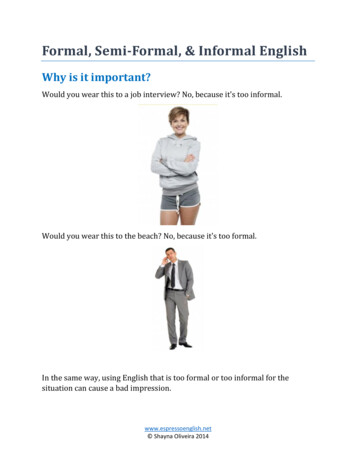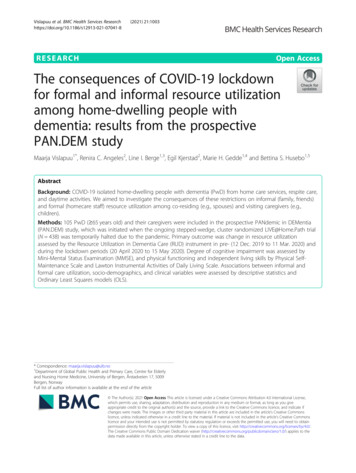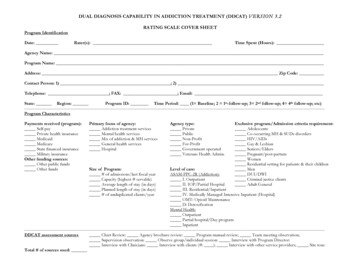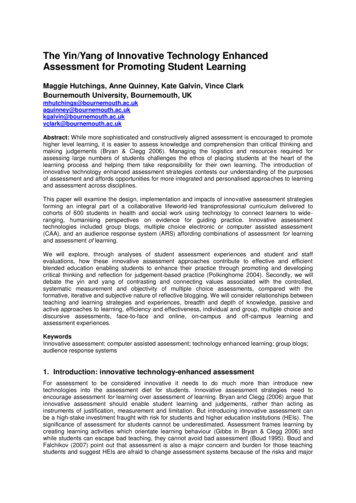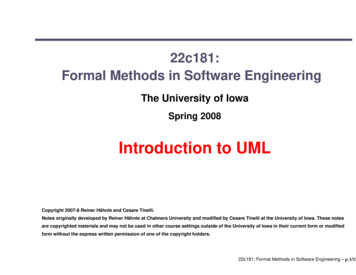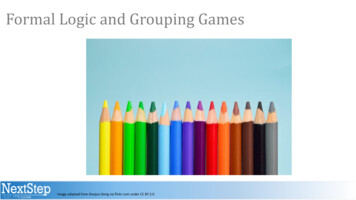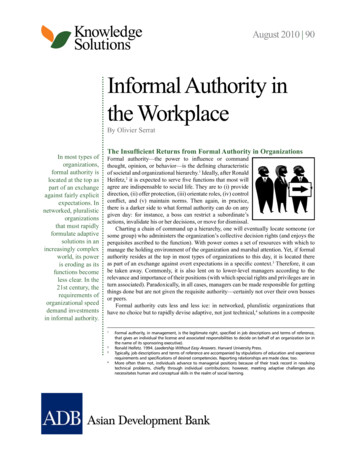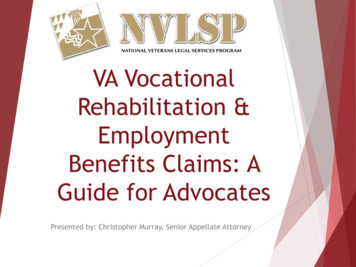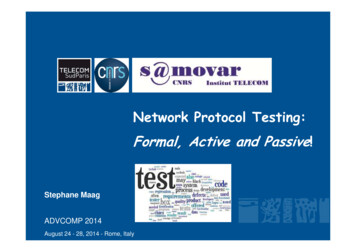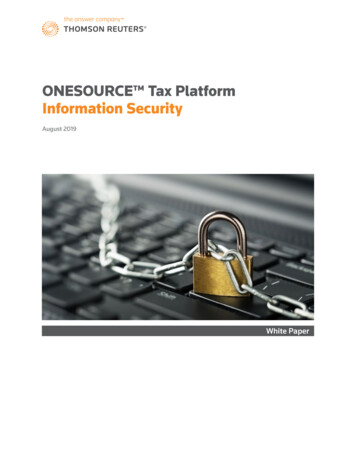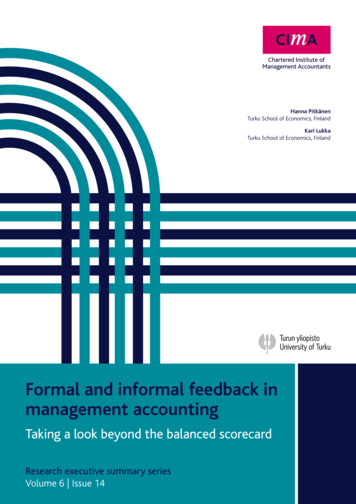
Transcription
clinical articleJ Neurosurg Pediatr 16:497–504, 2015Use of a formal assessment instrument for evaluation ofresident operative skills in pediatric neurosurgeryCaroline Hadley, BS, Sandi K. Lam, MD, MBA, Valentina Briceño, RN, Thomas G. Luerssen, MD,and Andrew Jea, MDDivision of Pediatric Neurosurgery, Texas Children’s Hospital and Department of Neurosurgery, Baylor College of Medicine,Houston, TexasObject Currently there is no standardized tool for assessment of neurosurgical resident performance in the operatingroom. In light of enhanced requirements issued by the Accreditation Council for Graduate Medical Education’s MilestoneProject and the Matrix Curriculum Project from the Society of Neurological Surgeons, the implementation of such a toolseems essential for objective evaluation of resident competence. Beyond compliance with governing body guidelines,objective assessment tools may be useful to direct early intervention for trainees performing below the level of theirpeers so that they may be given more hands-on teaching, while strong residents can be encouraged by faculty membersto progress to conducting operations more independently with passive supervision. The aims of this study were to implement a validated assessment tool for evaluation of operative skills in pediatric neurosurgery and determine its feasibilityand reliability.Methods All neurosurgery residents completing their pediatric rotation over a 6-month period from January 1, 2014,to June 30, 2014, at the authors’ institution were enrolled in this study. For each procedure, residents were evaluated bymeans of a form, with one copy being completed by the resident and a separate copy being completed by the attending surgeon. The evaluation form was based on the validated Objective Structured Assessment of Technical Skills forSurgery (OSATS) and used a 5-point Likert-type scale with 7 categories: respect for tissue; time and motion; instrumenthandling; knowledge of instruments; flow of operation; use of assistants; and knowledge of specific procedure. Data werethen stratified by faculty versus resident (self-) assessment; postgraduate year level; and difficulty of procedure. Descriptive statistics (means and SDs) were calculated, and the results were compared using the Wilcoxon signed-rank test andStudent t-test. A p value 0.05 was considered statistically significant.Results Six faculty members, 1 fellow, and 8 residents completed evaluations for 299 procedures, including 32ventriculoperitoneal (VP) shunt revisions, 23 VP shunt placements, 19 endoscopic third ventriculostomies, and 18 craniotomies for tumor resection. There was no significant difference between faculty and resident self-assessment scoresoverall or in any of the 7 domains scores for each of the involved residents. On self-assessment, senior residents scoredthemselves significantly higher (p 0.02) than junior residents overall and in all domains except for “time and motion.”Faculty members scored senior residents significantly higher than junior residents only for the “knowledge of instruments” domain (p 0.05). When procedure difficulty was considered, senior residents’ scores from faculty memberswere significantly higher (p 0.04) than the scores given to junior residents for expert procedures only. Senior residents’self-evaluation scores were significantly higher than those of junior residents for both expert (p 0.03) and novice (p 0.006) procedures.Conclusions OSATS is a feasible and reliable assessment tool for the comprehensive evaluation of neurosurgeryresident performance in the operating room. The authors plan to use this tool to assess resident operative skill development and to improve direct resident PEDS14511Key Words residency education; neurosurgery; surgery; operative skills; education assessmentAbbreviations ABNS American Board of Neurological Surgery; ACGME Accreditation Council for Graduate Medical Education; OPRS operative performancerating system; OSATS Objective Structured Assessment of Technical Skills for Surgery; PGY postgraduate year; VP ventriculoperitoneal.accompanying editorial See pp 495–496. DOI: 10.3171/2015.2.PEDS1542.submitted September 26, 2014. accepted January 21, 2015.include when citing Published online August 28, 2015; DOI: 10.3171/2015.1.PEDS14511. AANS, 2015J Neurosurg Pediatr Volume 16 November 2015497Unauthenticated Downloaded 08/30/22 09:22 AM UTC
C. Hadley et al.Aresident operative development is a keycomponent of neurosurgical training, means ofevaluating resident progress and skill acquisition are limited. Methods of evaluation of resident performance in the operating room, how skills develop overthe course of training, and how to best quantify operativeskills remain highly variable.8 While competency-basedresident education has been previously suggested as ameans of improving neurosurgical resident training, theoptimal means of evaluating competency have not beenestablished.11 Beginning in July 2013, the NeurologicalSurgery Milestone Project was launched as a joint initiative between the Accreditation Council for GraduateMedical Education (ACGME) and the American Boardof Neurological Surgery (ABNS). These milestones areintended to be metrics by which residency programs canevaluate resident performance on a semiannual basis andreport progress to the ACGME. Milestones include knowledge, attitude, and, notably, technical skills for each of theACGME competencies. Residents are assigned a levelof proficiency based on performance within each area ofevaluation, independent of postgraduate year. Milestoneperformance data for each program will be evaluated bythe Residency Review Committee as a component in theNext Accreditation System (NAS) to determine whetherresidents are progressing within a given program.19These milestones provide a standardized method ofevaluating performance, but they do not provide a standardapproach to evaluation of operative skill.19 Even beyondimplementation of these milestones, technical assessmenttools have been difficult to implement and, therefore, havenot become routine practice in most training programs.22A user-friendly evaluation tool could greatly improve resident evaluation and feedback. After reviewing the generaltechnical assessment tools available in the literature,1 wechose the Objective Structured Assessment of TechnicalSkills for Surgery (OSATS) global rating scale17 (Table1). This tool, developed and implemented in the generalsurgery residency program at the University of Toronto,was selected because it is widely used and published ingeneral surgery and has been validated for use in the clinical setting.4,13,15,17 This rating scale has an advantage overother means of evaluation, as it is not limited to a specificprocedure, as checklist-based evaluations often are. Thispermits a more comprehensive assessment of technicalproficiency.17Our aims were to implement a tool that assesses neurosurgical residents’ technical performance in the operating room and to determine the feasibility and reliabilityof such a tool as it relates to self-assessment, postgraduateyear (PGY) level, and procedure difficulty. Ideally, thistool could provide a standardized means of evaluatingresident proficiency, as well as provide information aboutthe level of operative skill that could be expected withinan individual rotation and within the residency programas a whole.lthoughMethodsCases and Research ParticipantsResidents completing their pediatric neurosurgery rota498tions were evaluated using the OSATS tool. This included 3 PGY-3s, 1 PGY-4, and 4 PGY-6s. Evaluations werealso completed for a pediatric neurosurgery fellow. Theseevaluations were considered for purposes of completiondata but were not analyzed against the resident evaluations(i.e., the fellow was not considered a resident). Evaluationforms were made available for all pediatric neurosurgicalprocedures performed at Texas Children’s Hospital between January 1, 2014, and June 30, 2014. Evaluations ofresident performance during the case were completed byone of 6 attending-level neurosurgeons. The faculty members who operated with the residents performed the evaluation immediately after completion of the cases. Residentsalso completed the OSATS form to evaluate their ownoperative performance. To minimize recall bias, all evaluation forms were required to be completed before leaving the operating room. Faculty and self-evaluation scoresfor each resident were compared, overall and within eachdomain. The forms were filled out independently. Evaluations were compared overall and then considered by procedure, excluding those procedures for which there wasonly a self-evaluation or only a faculty evaluation. Therate of response for all surgical cases in the study time period was 85.1% for faculty members and 87% for residents.Participation in this study was optional.The Baylor College of Medicine Institutional ReviewBoard granted educational exemption status for this project.Assessment ToolOur evaluation form (Table 1) is based on the OSATSglobal rating scale.13,17 The validated Global Rating Scaleof Operative Performance includes a 5-point Likert-typescale with 7 categories: respect for tissue; time and motion; instrument handling; knowledge of instruments; flowof operation; use of assistants; and knowledge of specificprocedure. Reznick and others6–8,16,17,23 have validated useof this grading scale for performance evaluation in benchmodels of surgical tissues. This scale and its variationshave also been used to evaluate general surgery residentperformance in the operating room in studies similar tothe present one.4,15The faculty evaluators discussed use of the evaluationtool to achieve uniformity in operative performance interpretation and evaluation.Statistical AnalysisWe evaluated construct validity by examining the difference in performance scores between faculty assessmentand self-assessment, both overall and in 7 domains of performance. Scores were also considered by resident level,with PGY-3s and PGY-4s considered together as juniorresidents and PGY-6s considered senior residents. Additionally, evaluations were compared by difficulty of procedure, designated either as novice or expert. These designations were assigned by a single faculty surgeon evaluator.Analysis was performed using commercially availableMicrosoft Excel and Stata 13 (StataCorp) statistical software. A p value 0.05 was considered significant.J Neurosurg Pediatr Volume 16 November 2015Unauthenticated Downloaded 08/30/22 09:22 AM UTC
Operative skills assessmentTABLE 1. Form used for evaluation of residents’ operative skillsHousestaff name: PGY LevelDate:Procedure:Attending:Who is completing this form (circle)? HousestaffAttendingGlobal Rating Scale of Operative PerformanceRespect for tissue1Frequently used unnecessary forceon tissue or caused damage byinappropriate use of instrumentsTime and motion1Many unnecessary movesInstrument handling1Repeatedly makes tentative or awkward moves with instruments byinappropriate use of instrumentsKnowledge of instruments1Frequently asked for wrong instrument or used inappropriateinstrumentFlow of operation1Frequently stopped operating andseemed unsure of next move23Careful handling of tissuebut occasionally causedinadvertent damage45Consistently handled tissueappropriately with minimaldamage23Efficient time/motion but someunnecessary moves45Clear economy of movementand maximum efficiency23Competent use of instrumentsbut occasionally appearedstiff or awkward45Fluid moves with instrumentsand no awkwardness23Knew names of most instruments and used appropriateinstrument45Obviously familiar with instruments and their names23Demonstrated some forwardplanning with reasonableprogression of procedure45Obviously planned course ofoperation with effortless flowfrom one move to the next23Appropriate use of assistantsmost of the time45Strategically used assistantsto the best advantage at alltimes23Knew all important steps ofoperation45Demonstrated familiarity with allaspects of operationUse of assistants1Consistently placed assistantspoorly or failed to use assistantsKnowledge of specific procedures1Deficient knowledge. Needed specific instruction at most stepsResultsFeasibilityOver a period of 6 months, 574 of 667 distributed assessments were completed, for a completion rate of 86%.Evaluations reflected 299 procedures, which were categorized as novice or expert (Table 2). Each of the 6 facultylevel surgeons completed evaluations for 62%–98% of theoperations they performed during the period of the study;112 evaluations were completed for the junior residents,and 93 evaluations were completed for the senior residents.Evaluations completed for a fellow in pediatric neurosurgery were not considered for purposes of this study. Eachof the 8 neurosurgery residents who rotated through pedi-atric neurosurgery during this 6-month period completedevaluations for 73%–100% of the surgical procedures inwhich they participated during the evaluation period. Thehigh rate of completion suggests that the use of this assessment tool is feasible for long-term evaluation of residentperformance. All evaluations were completed before leaving the operating room at the end of the case. No questionswere left blank.ValidityResident and faculty evaluations were compared overall using the Wilcoxon signed-rank test (Table 3). A significant difference between resident and faculty ratings wasJ Neurosurg Pediatr Volume 16 November 2015499Unauthenticated Downloaded 08/30/22 09:22 AM UTC
C. Hadley et al.TABLE 2. Novice- and expert-level procedures included in this studyNoviceExpertBaclofen pump placementBaclofen pump removalBur hole drainage—abscessBur hole drainage—subdural hematomaC-1 laminectomyChiari decompressionCraniotomy for hematoma evacuationDermoid cyst resectionDetethering of tethered cordDurotomy closureEVD placementExcision of skull lesionICP monitor placementInternal pulse generator battery exchangeLP shunt revisionLumbar decompressionLumbar wound washoutLumbosacral laminectomy and discectomyMcComb reservoir placementOccipital decompressionOmmaya reservoir placementRemoval of bullet in neckSelective dural rhizotomyVagus nerve stimulator battery exchangeVP shunt externalizationVP shunt placementVP shunt revisionAVM resectionAnterior cervical fusion with corpectomyCervical and thoracic laminectomy and intradural tumor resectionCervical decompression with posterior instrumented fusionCranial remodeling for craniosynostosisCranioplasty, LeFort III advancementCraniotomy for craniosynostosisCraniotomy for grid placementCraniotomy for resection of epileptic focusCraniotomy for tumor resectionEndoscopic biopsy of third ventricle with VP shunt placementEndoscopic exploration of interhemispheric arachnoid cystEndoscopic sagittal synostectomyEndoscopic third ventriculostomyGPi electrode placement for deep brain stimulationLumbar laminectomy with posterior fusionMetopic synostectomyMoyamoyaMyelomeningocele closureOccipitocervical fusionPineal tumor resectionPosterior fossa craniotomy for tumor resectionPosterior fossa tumor biopsyResection of right mastoid massThoracic posterior fusionTranssphenoidal resection of tumorVagus nerve stimulator placementVagus nerve stimulator revisionAVM arteriovenous malformation; EVD external ventricular drain; GPi globus pallidus internus; ICP intracranial pressure; LP lumboperitoneal.identified for overall scores (p 0.036) and in the domain“knowledge of procedures” (p 0.043). No other significant differences were identified. However, when facultyevaluations and self-evaluations were sorted by residentyear and compared, the Wilcoxon signed-rank test showedno significant difference between faculty evaluation andresident self-evaluation scores overall or in any of the 7domains of evaluation for either junior or senior residents.The correlation between resident and faculty scores fora given resident in a given procedure was evaluated bycalculating the Pearson’s r coefficient, which was 0.756,indicating a strong correlation between resident and faculty ratings.When faculty evaluations were compared between resident training levels, faculty members were found to scoresenior residents significantly higher than they scored junior residents in only 1 domain: “knowledge of instruments” (p 0.049). Otherwise, there was no significantdifference in faculty scores for junior and senior residents.Self-evaluations showed a much greater difference between junior and senior residents. Senior residents scored500themselves significantly higher than junior residentsscored themselves both overall (p 0.007) and in all individual domains (p 0.02), except for “time and motion”(Table 4).Evaluations were also considered based on the difficulty of the procedure being performed. In expert procedures, faculty members scored senior residents’ performance significantly higher than that of junior residents(p 0.04); however, there was no significant differencein scores given to junior and senior residents by facultymembers for novice procedures. Senior residents scoredtheir own overall performance significantly higher thanjunior residents scored theirs for both expert (p 0.006)and novice (p 0.03) procedures (Table 5).When faculty evaluations and self-evaluations from individual procedures were directly compared, all 4 juniorresidents gave themselves scores that differed significantlyfrom those given by faculty surgeons. Three junior residents gave themselves lower scores overall than facultymembers gave them (p 0.008), while 1 scored himselfhigher on self-evaluation than the faculty members scoredJ Neurosurg Pediatr Volume 16 November 2015Unauthenticated Downloaded 08/30/22 09:22 AM UTC
Operative skills assessmentTABLE 3. Overall comparison between resident and facultyevaluations*DomainOverallRespect for tissueTime and motionInstrument handlingKnowledge of instrumentsFlow of operationUse of assistantsKnowledge of np Value4.04 (0.73)4.15 (0.61)3.89 (0.76)4.06 (0.85)4.35 (0.78)3.87 (0.75)3.96 (0.72)3.97 (0.69)3.75 (0.72)3.91 (0.80)3.60 (0.76)3.69 (0.80)3.97 (0.82)3.65 (0.61)3.75 (0.78)3.68 (0.69)0.0360.0910.1610.0680.0760.0580.1410.043* Includes residents at all levels. Values are mean (SD) unless otherwiseindicated. Bold type indicates statistical significance; p values are based onthe Wilcoxon signed-rank test.him (p 0.04). In contrast, only 1 senior resident’s selfevaluation differed significantly (p 0.0007) from thescores given by the faculty surgeons.DiscussionRationale for Establishing a Rating ToolOne of the challenges of teaching clinical medicine andsurgery is recognizing how much a trainee should be allowed to undertake on his own without allowing the patient to be harmed under the hands of an inexperiencedpractitioner. These decisions are largely made based onsubjective assessment of resident skill and judgment;however, there is an increased effort in graduate medical education to implement standardized metrics to better assess resident competence and the overall quality ofresident education.11 While the emphasis on competenceassessment as a part of resident evaluation is not new,objective measures of neurosurgical trainee competenceacross a variety of procedures and skills have yet to beestablished.6,11 In the absence of an established standardfor resident performance, it can be difficult to know whatdegree of competence is appropriate for given skills at acertain level. Interest in the objective assessment of theseskills is growing rapidly.6In 2009, the ACGME began a campaign to reorganizeresident education based on the reported performance outcomes of residency programs within 6 prescribed areasof clinical competence, originally released in 2002.14,21 A2004 survey of neurosurgery residency program directorsindicated that the majority of directors felt that these corecompetencies were difficult to understand and many others felt that the core competencies were not beneficial asmetrics for resident progress or program success.12 Whilethe core competencies may not independently improve resident evaluation, these efforts also included steps towardthe implementation of standardized assessment methods.The first operative rating scale to be approved for use asa component of a program’s evaluation system accordingto the new guidelines was the operative performance rating system (OPRS) from the Southern Illinois UniversitySchool of Medicine.10 This system of evaluation relies onprocedure-specific evaluation of resident performance inselected sentinel general surgery procedures.10 Based onthis rating scale, the OSATS was developed to evaluateperformance independent of procedure.15 This assessmenttool has been validated for use to evaluate the performance of general surgery trainees, but it has not been usedto evaluate trainees in other surgical fields.2,3,8 Our studyrepresents the first effort to implement this rating scalefor evaluation of neurosurgery resident performance in theoperating room. This rating scale can be used to directfeedback following a case, track resident progress duringthe course of the rotation, and give the residency trainingprogram information about areas in which there may begaps in education.Using the OSATS for Evaluation of NeurosurgeryResidentsThe OSATS is a comprehensive tool, but integrationinto the operating room workflow is feasible, as evidencedby the high completion rate of 86% observed in our study.Additionally, all of our evaluation forms were completedbefore leaving the operating room, as compared with otherevaluation tools, such as the Southern Illinois UniversityOPRS, which faculty members took an average of 12 daysto complete in one study.9 Assessments performed in sucha delayed fashion suffer from recall bias, affecting theirvalidity. Early completion of assessments is important toTABLE 4. Comparison of mean scores of PGY-3 and -4 and PGY-6 for residents overall and for each domain of theOSATS*Attending EvaluationSelf-EvaluationDomainPGY-3 and 4PGY-6p ValuePGY-3 and 4PGY-6p ValueOverallRespect for tissueTime and motionInstrument handlingKnowledge of instrumentsFlow of operationUse of assistantsKnowledge of specific procedure3.58 (0.76)3.75 (0.62)3.49 (0.83)3.54 (0.84)3.84 (0.82)3.38 (0.73)3.49 (0.72)3.58 (0.80)4.49 (0.34)4.55 (0.27)4.27 (0.49)4.57 (0.53)4.87 (0.18)4.36 (0.39)4.42 (0.36)4.35 (0.29)0.0720.0570.1540.0820.0490.0540.0600.1193.17 (0.45)3.27 (0.51)3.16 (0.43)3.11 (0.49)3.30 (0.54)3.16 (0.40)3.10 (0.47)3.12 (0.41)4.3 (0.34)4.5 (0.44)4.0 (0.80)4.3 (0.60)4.6 (0.31)4.1 (0.26)4.4 (0.29)4.3 (0.31)0.0070.0090.1030.0240.0050.0060.0030.004* Values represent mean (SD) unless otherwise indicated; p values are based on Student t-test.J Neurosurg Pediatr Volume 16 November 2015501Unauthenticated Downloaded 08/30/22 09:22 AM UTC
C. Hadley et al.TABLE 5. Mean overall scores for PGY-3 and -4 and PGY-6 residents based on procedure difficulty in both facultyevaluations and self-evaluations*Expert-Level ProceduresNovice-Level ProceduresMeasurePGY-6PGY-3 and 4p ValuePGY-6PGY-3 and 4p ValueAttending evaluation, overall averageSelf-evaluation, overall average4.48 (0.28)4.22 (0.33)3.30 (0.84)3.20 (0.54)0.0420.0264.48 (0.46)4.6 (0.27)3.64 (0.76)3.22 (0.46)0.1120.006* Values represent mean (SD) unless otherwise indicated; p values are based on Student t-test. Bold type indicates statistical significance.provide more accurate results and more timely feedbackfor residents. Completion of the modified OSATS evaluation form is not time consuming, which may improvecompliance and accuracy. Participants in our study werenot asked to time their completion of the survey; however, previous studies using the same tools have found thatcompletion takes between 2 and 5 minutes.4 Other explanations may be that the 6 faculty members involved in ourstudy have a high interest in surgical education and weremotivated to participate in the study. The high completionrate suggests that residents and faculty found the evaluation tool useful, as both groups appear to have prioritizedsurvey completion even though completion was entirelyvoluntary.Construct validity for neurosurgical residents wasevaluated by comparison of evaluation scores between junior and senior residents and for novice and expert procedures. While faculty scores were significantly higher thanresident scores both overall and in one of the domains ofevaluation, this difference disappeared once scores weresorted by level of training. There were no significant differences between self-evaluation and faculty evaluationscores for either junior or senior residents in all domains ofthe scale, suggesting that the rating scale is, on the whole,a reliable representation of performance. This was furtherconfirmed by the strong correlation between resident andattending scores (r 0.756). When procedures were considered based on difficulty, average scores assigned byfaculty surgeons for expert procedures were significantlyhigher for senior residents (Table 5), suggesting that thistool does reflect resident progress, particularly in performance of more complicated operative tasks.When self-evaluation scores were compared betweenjunior and senior residents, there was a significant difference between junior and senior resident scores overall andfor all but 1 domain. However, when faculty surgeon scoresfor junior and senior residents were compared, there wasa significant difference in only 1 domain of performance.This may indicate that residents’ evaluations of their ownskills are more sensitive to minor improvements, whereasfaculty surgeons may be less sensitive to improvement inthe performance of more simple procedures. The observation that there is a significant difference between facultyevaluation of junior and senior residents during more difficult procedures further supports this idea. This findingsuggests that self-evaluation may be an important component of evaluation of resident progress.While, overall, self-evaluation and faculty scores werenot significantly different, when self-evaluation and faculty scores were compared on an individual resident basis, 3of 4 junior residents scored themselves significantly lower502than the faculty members scored them, while senior resident scores were individually more consistent with facultyevaluation. While this may simply represent a desire to notoverestimate one’s skill as a junior resident, it may indicatethat residents become better able to assess the quality oftheir own performance as they progress through the training program.Limitations and Future DirectionsA major limitation of our study is that it was performedat a single institution. It is possible that the use of this assessment tool would produce different results at anotherinstitution. A second limitation is the small number ofresidents who rotate through the pediatric neurosurgeryservice and the number of faculty members on the pediatric neurosurgery staff. This study was also limited toa short time frame of only 6 months. Going forward, weplan to examine a longer period, ideally including multiple rotations and progression of resident level of trainingin the analysis. These preliminary findings are beneficial,however, as they may encourage others to adopt this assessment tool, permitting consideration of multiple institutions in future analyses and thus increasing the power ofthe results.The small number of residents also limits the power ofthe current study. A sample calculation was performed forthe OSATS using a predetermined power of 0.8, p 0.05,and a large effect size (Cohen’s d 0.86). This indicatedthat 26 residents would be required to achieve these results.Our current sample size of 8 residents limits our ability toidentify significant differences in performance and correlations between experience and performance. These 8 residents represent 8 out of a total of 12 residents who rotatein pediatric neurosurgery at our institution in a given year.This small class size calls for a multiinstitutional approachin future work to ensure a sufficient sample size.An additional limitation is the unblinded nature of thisstudy. Since the evaluators were the surgeons who operated with the resident, they were aware of the resident’sidentity, which may affect the results. Future directions forresearch may lead us to video-based assessment of residentoperative skill, which can limit personal bias; however,this would also limit the domains that could be evaluated.Our current study was also limited by the variability inthe number of evaluation forms completed for each resident. The completed forms do not represent performanceover the course of the entire pediatric neurosurgery rotation. Residents are expected to improve their performanceon surgical procedures over a subspecialty-focused rotation, and evaluation of this progression of skill would beuseful.8 In the future, we plan to evaluate the longitudinalJ Neurosurg Pediatr Volume 16 November 2015Unauthenticated Downloaded 08/30/22 09:22 AM UTC
Operative skills assessmentvalidity of the OSATS evaluation tool during the pediatricneurosurgery rotation.Additionally, our validation of the OSATS as a reproducible measure of competence was limited by lack of datato determine inter-attending variability in rating. Onlyone attending surgeon observed each procedure. Therewas considerable variation in the procedures and levelof difficulty, and there was considerable variation in thenumber of evaluations each faculty surgeon completed foreach resident. Because of this variation, we were unableto compare the scores given by multiple attending physicians to a given resident performing a single procedureto confirm reproducibility. Going forward, asking severalfaculty surgeons to evaluate the same
ment a validated assessment tool for evaluation of operative skills in pediatric neurosurgery and determine its feasibility and reliability. methods All neurosurgery residents completing their pediatric rotation over a 6-month period from January 1, 2014, to June 30, 2014, at the authors' institution were enrolled in this study.
